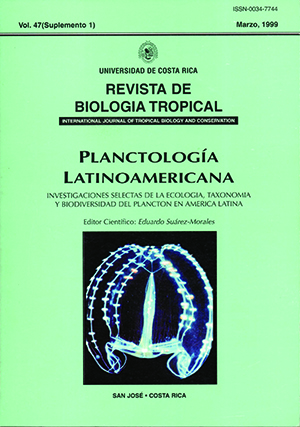Resumen
Se determinó la fluctuación. estacional de las densidades del bacterioplancton en cinco cenotes y dos cuevas anquihalinas del noreste de Quintana Roo, Península de Yucatán. Las densidades del bacterioplancton fueron extremadamente bajas (5.8 ± 0.35 x 102 - 8 ± 0.48 x 103 cél/ml). Las densidades bacterianas de los cenotes (5.8 ± 0.35 x 102 - 4.3 ± 0.26 x 103 cél/ml) fueron más bajas que en las cuevas (2.7 ± 0.16 x 103 - 8 ± 0.48 x 103 cél/ml). El agua de lluvia que se percola a las cuevas a través del suelo de la selva rico en materia· orgánica particulada (MOP) y. disuelta (MOD), promueve densidades bacterianas más elevadas. Los cenotes y las cuevas se caracterizaron por ser ambientes de ultraoligotróficos. a oligotróficos como lo indican las concentraciones bajas de nutrimentos (0.05 - 1.7 μM P total, 34.89 - 250.9 μM N total) así como las densidades bacterianas reducidas.
Citas
Alcocer, l, A. Lugo, L.E. Marín & E. Escobar, 1998. Hydrochemistry of waters from five cenotes aild evaluation of their suitability for drinking-water supplies, northeastem Yucatan, Mexico. Hydrogeol. J. 6: 293-310.
Brigmon, R.L., H.W. Martin, T.L. Morris, G. Bitton & S.G. Zam. 1994. Biochemical ecology of Thiothrix spp. in Wlderwater limestone caves. Geomicrobiol. J. 12: 141-159.
Brigmon, R.L. & T.L. Morrls. 1995. Diving protocol for sterile sampling of aquifer bacteria in underwater caves. Nation. Speleol. Soc. Bull. 57; 24-30.
Culver, D.C. 1994. Species interáctions. p. 271-285. In J. Gibert, D:L. DanieJopol & J.A. StanfQrd (eds.). Groundwater ecology. Academic Press, San
Diego.
Edler, C. & W.K. Dodds. 1992. Characterization of a groundwater cornmunity. donúnated by Caecidotea tridentata (Isopoda). First Intemátional Conference
on Groundwater Ecology.USEPA & American Water Resources Association. Kansas. p. 91-99.
Edler, C. & W.K. Dodds. 1996. The ecology of a subterranean isopod, Caecidotea tridentata. Freshwat. Biol. 35; 249-259.
Escobar- Briones, E.; M.E. Camacho & J. Alcocer. 1997. Calliasmata nohochi, new species (Decapoda: Caridea: Hippolytidae), from, anchialine cave systems in continental Quintana Roo, Mexico. J. Crost. Biol. 17: 733-744.
Fuks, D., R. Precali & M. Devescovi. 1994. Bacterial production in the stratified karstic estuary of the Krka river. Acta Adriat. 34: 21-28
Golterman, H.L. 1984. Sediments, modifying and equílibrating factors in the chemistry of freshwater. Verh. lnt. Verein. Limnol. 22: 23-59.
Gounot, A.M. 1994. Microbial ecology of groundwaters. p. 189-215. In 1. Gibert, D.L. Danielopol & JA Stanford (eds.). Groundwater ecology. Academic
Press. London.
Herrera-Silveira, l.A. 1994. Nutrients from underground water díscharges in a coastal lagoon (Celestun, Yucatan, Mexico). Verh. Int. Verein. Limnol. 25: 1398-1401
Herrera-Silveira, J.A., F.A. Conún, S.López & 1. Sánchez. 1998. Limnologícal characterization of aquatic ecosystems in Yucatan Península (SE Mexico). Verh.
lnt. Verein. Limnol. 26: 1348-1351.
Lesser, J.A. & A.E. Weidie. 1988. Region 25. Yucatan Peninsula. p. 237-241. In W. Buck, J.S. Rosenheín & P.R- Seaber (eds.). The geology of North America. Geological Society of America. Boulder.
López-Adrián, S. & J.A. Herrera- Silveira. 1994. Plankton composition in a cenote, Yucatan, Mexico. Verh. Int. Vereín. Limnol. 25: 1402-1405.
Marín, L.E. & E.e. Perry. 1994. The hydrogeology and contumination potential of northwestem Yucatan, Mexico. Geofís. lnt. 33: 619-623
Martín, HW., RL Brigmon & T.L. Moms. 1995. Diving protocol for sterile sampling of aquifer bacteria in underwater caves. Nation. Speleol. Soco Bull. 57: 24-30.
Margalef, R. 1983. Limnología. Omega. Barcelona. 1010 p.
Ochs, C.A., J.J. Cole & O.E. Likens. 1995. Population dynamics of bacterioplankton in an oligotrophic lake. J. Plunkton Res. 17: 365-391.
Pacheco, J. & E. V ázquez. 1992. Impacto de la porcicultura en el contenido de nitratos del agua subtenánea. VlIl Congreso Nacional de la Sociedad Mexicana de Ingeniería Sanitaria y Ambiental, A.C. Morelos.
Pacheco, J. & A. Cabrera. 1997. Groundwater contamination by nitrates in the Yucatan Península, Mexico. Hydrogeol. J. 5: 47-53.
Parsons, T.R., Y Maita & C.M. Lalli. 1984. A manual of chemical and biological methods of seawater analysis. Pergamon Press. London. 173 p.
Porter, K.O. & YS. Feig. 1980. The use of DAPT for identifying and counting aquatic microflora. Limnol. Oceanogr. 25: 943-948.
Salas, H.J. & P. Martino. 1988. Desarrollo de metodologías simplificadas para la evaluación de eutroficación en lagos cálidos tropicales. Cuarto Encuentro "Eutroficación de lagos tropicales". CEPIS. San Juan de Puerto Rico. 69 p.
Simek, K., M. Macek, J. Pemthaler, V. Straskrabova & R. Psenner. 1996. Can freshwater planktonic ciliates survive on a diet of picoplankton? J. Plankton Res. 18: 597-613.
Stirling, H.P. 1985. Chemical and biological methods of water analysis for aquaculturists. Institute of Aquaculture, University of Stirling. Scotland.
p.
Stoessel, R.K., YH. Moore & J.O. Coke, 1993. The ocurrence and effect of sulfate reduction and sulfide oxidation on coastal limestone dissolution in Yucatan cenotes. Groundwater 31: 566-575.
Strickland, J.D.H. & T.R. Parsons. 1972. A practical handbook of seawater analysis. Bul!. Fish. Res. Board. Can. 167: 1-310.
Valdstein, O., A. Jensen, y. Olsen & H. Reinertsen. 1988 Growth and phosphorus status of limnetic phytoplankton and bacteria. Limnol. Oceanogr. 33: 489-503.
Wetzel, R.O. & G.E. Likens. 1979. Limnological analyses. Saunders. Philadelphia. 375 p.
##plugins.facebook.comentarios##

Esta obra está bajo una licencia internacional Creative Commons Atribución 4.0.
Derechos de autor 1999 Revista de Biología Tropical


